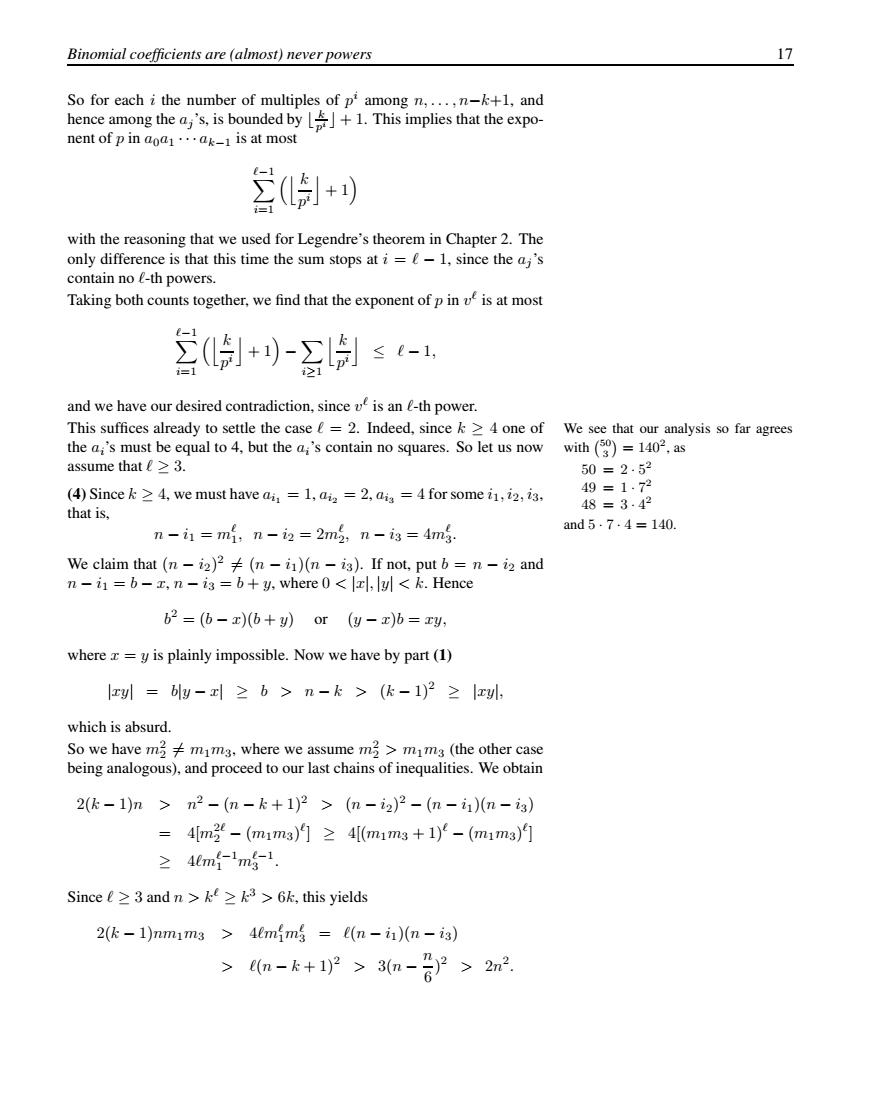正在加载图片...

Binomial coefficients are (almost)never powers 17 So for each i the number of multiples of p'among n,...,n-k+1,and hence among the a,'s,is bounded by+1.This implies that the expo- nent of p in aoa1...ak-1 is at most + with the reasoning that we used for Legendre's theorem in Chapter 2.The only difference is that this time the sum stops at i =-1,since the aj's contain no e-th powers. Taking both counts together,we find that the exponent of p in v is at most (制+)-制 ≤-1, i1 i1 and we have our desired contradiction,since vt is an e-th power. This suffices already to settle the case e=2.Indeed,since k>4 one of We see that our analysis so far agrees the a's must be equal to 4.but the a's contain no squares.So let us now with ()=1402.as assume that e≥3. 50=2.52 (4)Sincek 4,we must have ai 1,aiz=2,aia =4 for some i1,i2,i3. 49=1.72 that is, 48=3.42 and5.7.4=140. n-i1 mi:n-i2 2m2,n-i3 4mg. We claim that (n-i2)2 (n-i1)(n -i3).If not,put b n i2 and n-i1=b-t,n-i3=b+y,where 0<,ly<k.Hence 62=(b-z)(b+y)or (y-x)b=IV, where z=y is plainly impossible.Now we have by part(1) lz=ly-x≥b>n-k>(k-1)2≥x, which is absurd. So we have mz mim3,where we assume m>mim3(the other case being analogous),and proceed to our last chains of inequalities.We obtain 2(k-1)n>n2-(n-k+1)2>(n-i2)2-(m-i1)(n-ig) =4[m-(m1m3)≥4(m1m3+1)-(m1m3)1 ≥4lmf-lm5-1. Since≥3andn>kt≥k3>6k,this yields 2(k-1)nmim3 4emims e(n-i1)(n-i3) >4n-k+12>3n-62>2m2Binomial coefficients are (almost) never powers 17 So for each i the number of multiples of pi among n, . . . , n−k+1, and hence among the aj ’s, is bounded by k pi + 1. This implies that the exponent of p in a0a1 ··· ak−1 is at most −1 i=1
k pi
+ 1 with the reasoning that we used for Legendre’s theorem in Chapter 2. The only difference is that this time the sum stops at i = − 1, since the aj ’s contain no -th powers. Taking both counts together, we find that the exponent of p in v is at most −1 i=1
k pi
+ 1 − i≥1
k pi
≤ − 1, and we have our desired contradiction, since v is an -th power. We see that our analysis so far agrees with 50 3 = 1402, as 50 = 2 · 52 49 = 1 · 72 48 = 3 · 42 and 5 · 7 · 4 = 140. This suffices already to settle the case = 2. Indeed, since k ≥ 4 one of the ai’s must be equal to 4, but the ai’s contain no squares. So let us now assume that ≥ 3. (4) Since k ≥ 4, we must have ai1 = 1, ai2 = 2, ai3 = 4 for some i1, i2, i3, that is, n − i1 = m 1, n − i2 = 2m 2, n − i3 = 4m 3. We claim that (n − i2)2 = (n − i1)(n − i3). If not, put b = n − i2 and n − i1 = b − x, n − i3 = b + y, where 0 < |x|, |y| < k. Hence b2 = (b − x)(b + y) or (y − x)b = xy, where x = y is plainly impossible. Now we have by part (1) |xy| = b|y − x| ≥ b>n − k > (k − 1)2 ≥ |xy|, which is absurd. So we have m2 2 = m1m3, where we assume m2 2 > m1m3 (the other case being analogous), and proceed to our last chains of inequalities. We obtain 2(k − 1)n>n2 − (n − k + 1)2 > (n − i2) 2 − (n − i1)(n − i3) = 4[m2 2 − (m1m3) ] ≥ 4[(m1m3 + 1) − (m1m3) ] ≥ 4m−1 1 m−1 3 . Since ≥ 3 and n>k ≥ k3 > 6k, this yields 2(k − 1)nm1m3 > 4m 1m 3 = (n − i1)(n − i3) > (n − k + 1)2 > 3(n − n 6 ) 2 > 2n2.��